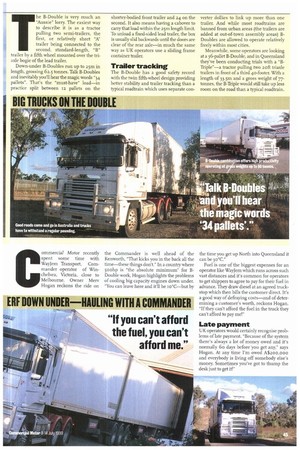BIG TRUCKS ON THE DOUBLE
Page 47

If you've noticed an error in this article please click here to report it so we can fix it.
he B-Double is very much an "Aussie" lorry. The easiest way to describe it is as a tractor pulling two semi-trailers, the first, or relatively short "A' trailer being connected to the second, standard-length, "B" trailer by a fifth wheel mounted over the triaxle bogie of the lead trailer.
Down-under B-Doubles run up to 25m in length, grossing 62.5 tonnes. Talk B-Doubles and inevitably you'll hear the magic words "34 pallets". That's the "must-have" load—in practice split between 12 pallets on the
shorter-bodied front trailer and 24 on the second. It also means having a cabover to carry that load within the 25m length limit. To unload a fixed-sided lead trailer, the box is usually slid backwards until the doors are clear of the rear axle—in much the same way as UK operators use a sliding frame container trailer.
Trailer tracking
The BDouble has a good safety record with the twin fifth-wheel design providing better stability and trailer tracking than a typical roadtrain which uses separate con venter dollies to link up more than one trailer. And while most roadtrains are banned from urban areas (the trailers are added at out-of-town assembly areas) BDoubles are allowed to operate relatively freely within most cities.
Meanwhile, some operators are looking at a 36-pallet B-Double, and in Queensland they've been conducting trials with a "13Triple"—a tractor pulling two 2oft triaxle trailers in front of a third 404-Doter. With a length of 33.5m and a gross weight of 77tonnes, the B-Triple would still take up less room on the road than a typical roadtrain.








































































































